Land Use, Conservation, Forestry, and Agriculture in Puerto Rico
Abstract
:1. Introduction
2. Materials and Methods
2.1. Lands Well-Suited for Agriculture
2.2. Lands Well-Suited for Forestry
2.3. Farmland Soils
2.4. Lands Well-Suited for Conservation, Agriculture, and Forestry Uses
2.5. Current Agricultural Productivity
2.6. Current Land Cover and Zoning
3. Results
3.1. Lands Well-Suited for Agriculture
3.2. Lands Well-Suited to Forestry
3.3. Farmland Classification of Soils
3.4. Characterizing Suitability for Conservation, Agriculture, and Forestry
3.5. Lands in Agricultural Productivity
3.6. Current Land Cover and Land Use
4. Discussion
5. Conclusions
Acknowledgments
Author Contributions
Conflicts of Interest
Appendix A
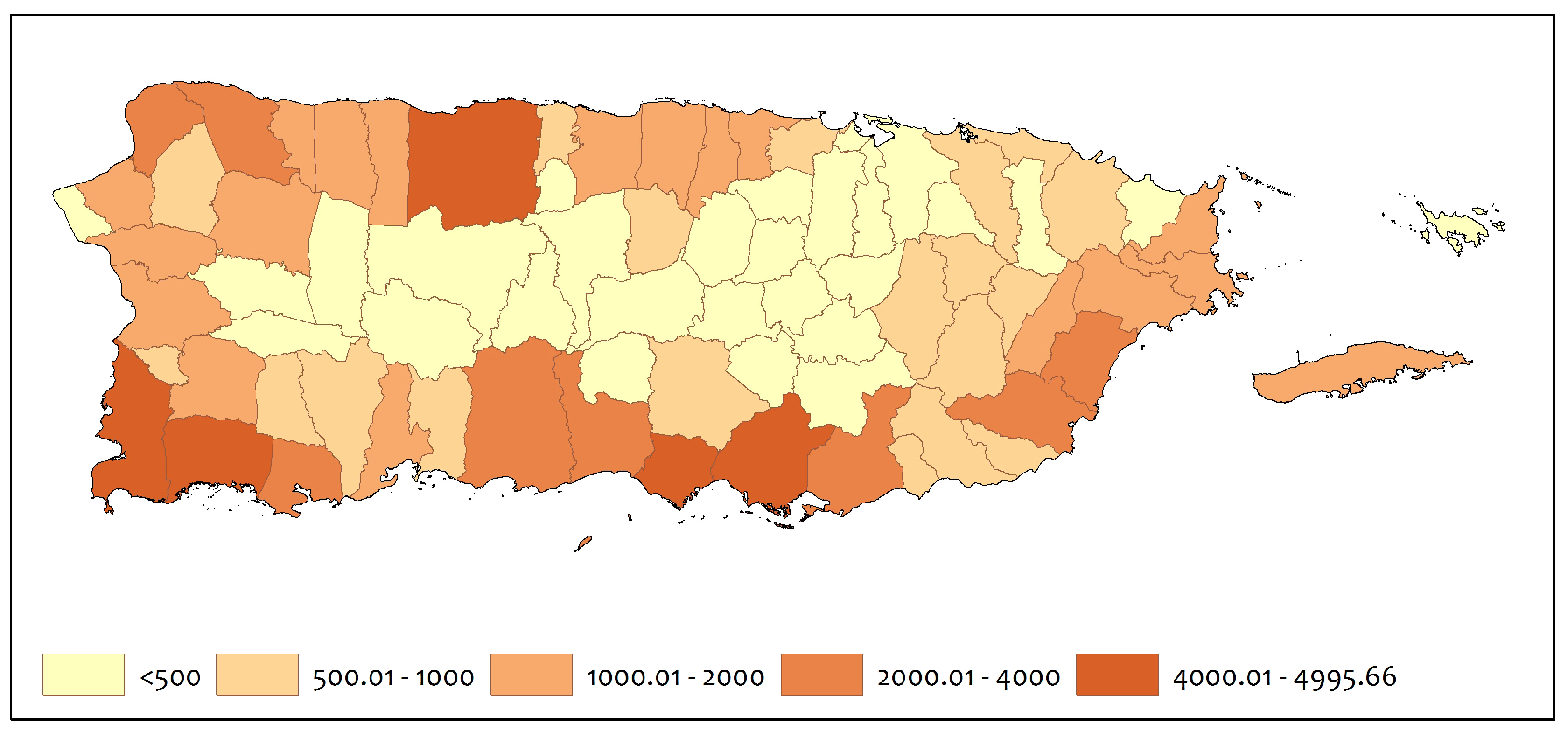
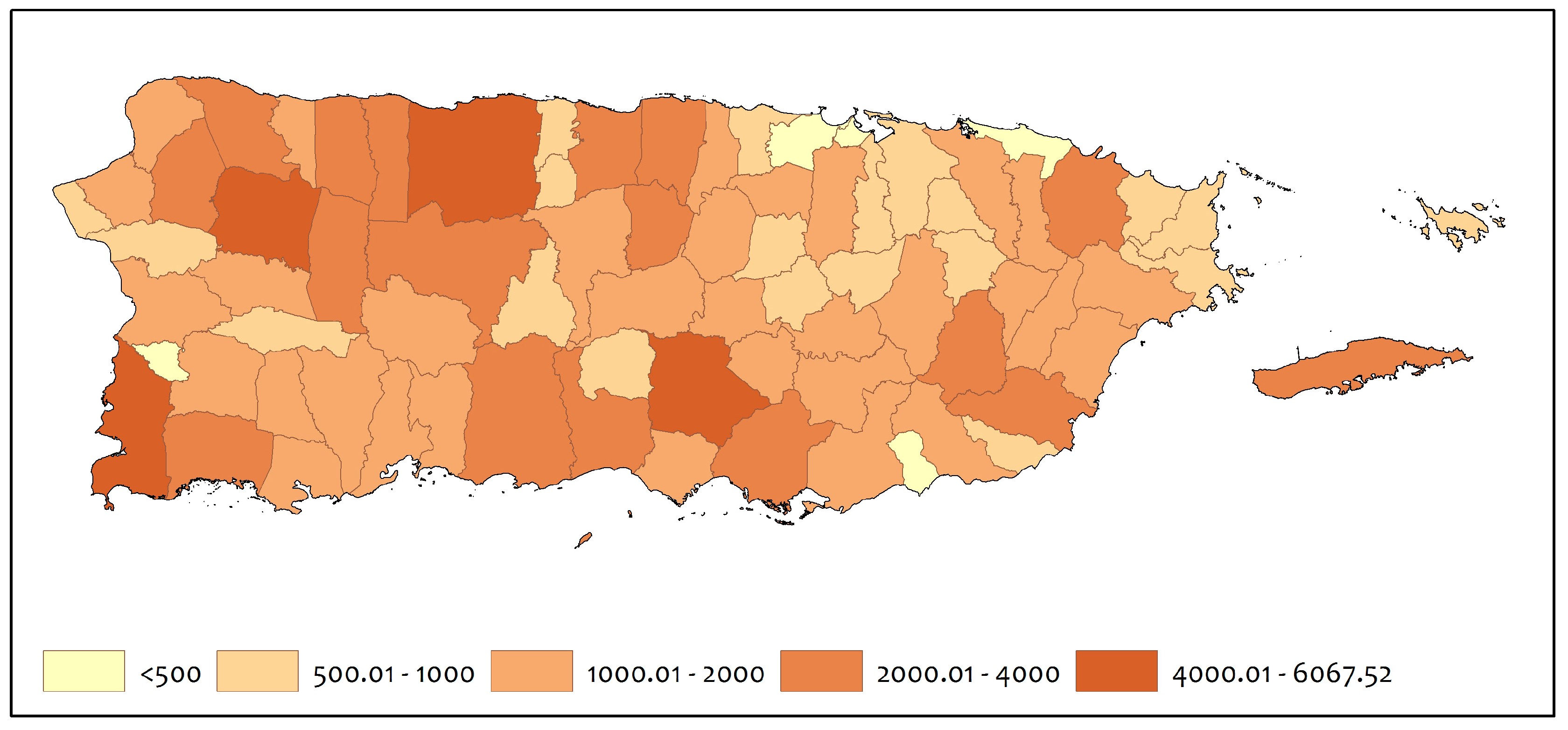
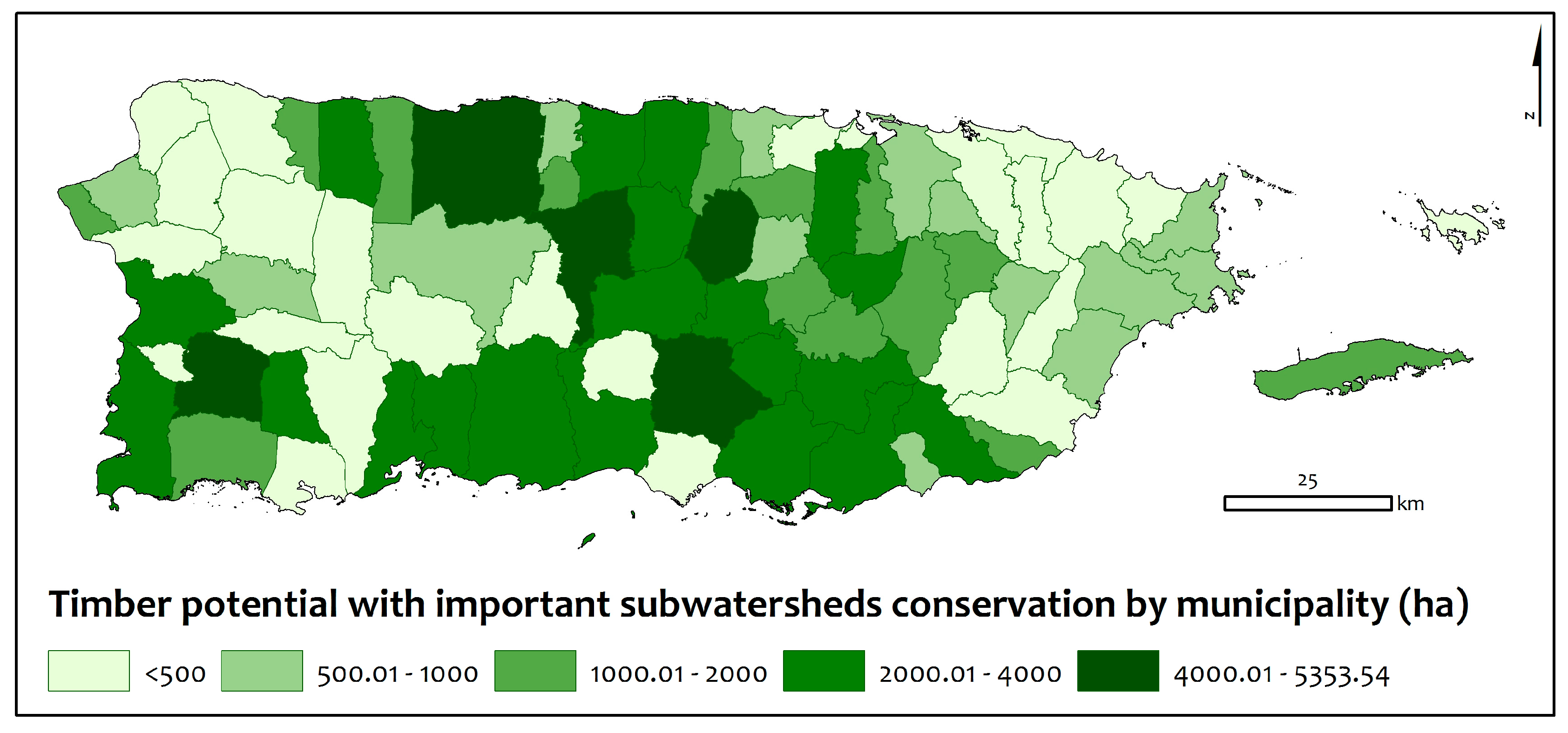
| Municipality | Lands Well-Suited (ha) | |||
|---|---|---|---|---|
| Land Well-Suited for Mechanized Agriculture: <10 Percent Slope | Land Well-Suited for Non-Mechanized Agriculture: 10 to 20 Percent Slope | Land Well-Suited for Forestry | Lands Well-Suited for Conservation | |
| Añasco | 1653 | 672 | 1041 | 5874 |
| Adjuntas | 244 | 1037 | 1086 | 14,302 |
| Aguada | 1223 | 747 | 2334 | 2261 |
| Aguadilla | 3880 | 1031 | 416 | 1698 |
| Aguas Buenas | 216 | 762 | 3363 | 2801 |
| Aibonito | 470 | 923 | 2486 | 3306 |
| Arecibo | 6930 | 3161 | 6205 | 12,964 |
| Arroyo | 965 | 206 | 905 | 1268 |
| Barceloneta | 1245 | 394 | 588 | 1739 |
| Barranquitas | 249 | 867 | 3941 | 3004 |
| Bayamón | 704 | 743 | 1942 | 2757 |
| Cabo Rojo | 6021 | 2749 | 2361 | 5394 |
| Caguas | 1063 | 1136 | 1126 | 7935 |
| Camuy | 3100 | 2024 | 2982 | 2741 |
| Canóvanas | 692 | 778 | 793 | 5044 |
| Carolina | 1040 | 752 | 2255 | 3846 |
| Cataño | 97 | 1 | 0 | 520 |
| Cayey | 559 | 922 | 2578 | 7870 |
| Ceiba | 1255 | 708 | 1072 | 3557 |
| Ciales | 473 | 1328 | 5885 | 8979 |
| Cidra | 652 | 1245 | 1706 | 4535 |
| Coamo | 1756 | 2880 | 5076 | 9313 |
| Comerío | 163 | 574 | 1193 | 4942 |
| Corozal | 487 | 1358 | 5031 | 3235 |
| Culebra | 313 | 575 | 1108 | 895 |
| Dorado | 1629 | 396 | 713 | 1815 |
| Fajardo | 1223 | 550 | 606 | 3895 |
| Florida | 484 | 509 | 1261 | 1335 |
| Guanica | 2719 | 874 | 835 | 4363 |
| Guayama | 3462 | 1006 | 3416 | 7270 |
| Guayanilla | 1363 | 1022 | 3159 | 4565 |
| Guaynabo | 409 | 547 | 1870 | 1487 |
| Gurabo | 1151 | 522 | 1789 | 2500 |
| Hatillo | 3263 | 1882 | 2373 | 1833 |
| Hormigueros | 1016 | 188 | 473 | 622 |
| Humacao | 2535 | 1129 | 2845 | 2825 |
| Isabela | 4302 | 1461 | 10 | 6867 |
| Jayuya | 250 | 729 | 603 | 9404 |
| Juana Díaz | 4426 | 1397 | 3300 | 4745 |
| Juncos | 1305 | 752 | 1086 | 2610 |
| Lajas | 5693 | 1586 | 1853 | 5249 |
| Lares | 1188 | 2466 | 2928 | 8373 |
| Las Marías | 248 | 994 | 4036 | 6338 |
| Las Piedras | 1554 | 945 | 2069 | 3079 |
| Loíza | 770 | 33 | 7 | 3765 |
| Luquillo | 687 | 601 | 1471 | 3215 |
| Manatí | 2212 | 1235 | 2807 | 4050 |
| Maricao | 108 | 541 | 3024 | 5532 |
| Maunabo | 662 | 403 | 2266 | 1706 |
| Mayagüez | 1384 | 1177 | 5062 | 9611 |
| Moca | 1400 | 2315 | 3517 | 4461 |
| Morovis | 1100 | 1407 | 3251 | 3403 |
| Naguabo | 2065 | 1030 | 1790 | 7585 |
| Naranjito | 153 | 550 | 961 | 4731 |
| Orocovis | 245 | 1218 | 6479 | 7793 |
| Patillas | 836 | 675 | 2410 | 7687 |
| Peñuelas | 884 | 850 | 3757 | 4871 |
| Ponce | 3245 | 1709 | 2700 | 16,826 |
| Quebradillas | 1711 | 871 | 1075 | 1530 |
| Río Grande | 1393 | 1473 | 387 | 10,847 |
| Rincón | 349 | 402 | 1405 | 834 |
| Sabana Grande | 989 | 804 | 2331 | 4117 |
| Salinas | 5675 | 1164 | 2290 | 7379 |
| San German | 1908 | 1368 | 4882 | 4575 |
| San Juan | 675 | 515 | 486 | 2596 |
| San Lorenzo | 1073 | 1651 | 2639 | 7303 |
| San Sebastian | 2593 | 4329 | 3571 | 6256 |
| Santa Isabel | 4889 | 606 | 341 | 1996 |
| Toa Alta | 890 | 1150 | 1066 | 2328 |
| Toa Baja | 1012 | 162 | 312 | 2352 |
| Trujillo Alto | 408 | 625 | 1103 | 1861 |
| Utuado | 928 | 2538 | 4326 | 20,804 |
| Vega Alta | 1596 | 758 | 1718 | 2011 |
| Vega Baja | 2496 | 1156 | 2397 | 4077 |
| Vieques | 1904 | 1278 | 1009 | 8496 |
| Villalba | 241 | 755 | 219 | 7746 |
| Yabucoa | 3147 | 1553 | 5051 | 3413 |
| Yauco | 831 | 1137 | 313 | 13961 |
| Total | 124,131 | 84,564 | 169,120 | 399,672 |
| NRCS Soils Farm Classification | Area (ha) | |||
|---|---|---|---|---|
| Land Well-Suited for Mechanized Agriculture: (Slope <10 Percent) | Land Well-Suited for Non-Mechanized Agriculture: 10 to 20 Percent Slope | Land Better Suited for Forestry, Conservation, or Developed Land Uses | Total | |
| All areas are prime farmland | 30,513 | 9153 | 37,656 | 77,323 |
| Farmland of statewide importance | 20,817 | 14,805 | 63,180 | 98,803 |
| Farmland of statewide importance, if irrigated | 167 | 99 | 174 | 440 |
| Not prime farmland | 40,185 | 56,449 | 568,113 | 664,746 |
| Prime farmland if drained | 6318 | 312 | 8152 | 14,783 |
| Prime farmland if irrigated | 19,850 | 2616 | 18,883 | 41,350 |
| Prime farmland if irrigated and reclaimed of excess salts and sodium | 1378 | 17 | 1921 | 3316 |
| Prime farmland if protected from flooding or not frequently flooded during the growing season | 30 | 30 | ||
| no data | 4837 | 1104 | 22,539 | 28,481 |
| Total | 124,065 | 84,555 | 720,648 | 929,270 |
References
- Food and Agriculture Organization of the United Nations (FAO). Global Agriculture Towards 2050: How to feed the world in 2050. In Proceedings of the High Level Expert Forum, Rome, Italy, 12–13 October 2009; pp. 1–35. [Google Scholar]
- Ludena, C.E. Agricultural Productivity Growth, Efficiency Change And Technical Progress in Latin America and the Caribbean; Research Dept. II. Title. III. Working Paper Series; Inter-American Development Bank: Washington, DC, USA, 2010; p. 186. [Google Scholar]
- Walters, L.M.; Jones, K.G. Caribbean Food Import Demand: Influence of the Changing Dynamics of the Caribbean Economy. In Proceedings of the Southern Agricultural Economics Association Annual Meetings, Birmingham, AL, USA, 4–7 February 2012; p. 19. [Google Scholar]
- Carro-Figueroa, V. Agricultural Decline and Food Import Dependency in Puerto Rico: A Historical Perspective on the Outcomes of Postwar Farm and Food Policies. Caribb. Stud. 2002, 30, 77–107. [Google Scholar]
- Kendall, P.; Petracco, M. The Current State and Future of Caribbean Agriculture. J. Sustain. Agric. 2009, 33, 780–797. [Google Scholar] [CrossRef]
- Comas, M. Vulnerabilidad De Las Cadenas De Suministros, El Cambio Climático Y El Desarrollo De Estrategias De Adaptación: El Caso De Las Cadenas De Suministros De Alimento De Puerto Rico. Ph.D. Thesis, University of Puerto Rico, Mayaguez, Puerto Rico, 2009. [Google Scholar]
- Galtier, F.; Vindel, B. Managing Food Price Instability in Developing Countries: A Critical Analysis of Strategies and Instruments; Agence Française de Développement: Paris, France, 2013. [Google Scholar]
- Watlington, F. Cassava and carrying capacity in aboriginal Puerto Rico: Revisiting the Taino downfall at conquest. Southeast. Geogr. 2009, 49, 394–403. [Google Scholar] [CrossRef]
- Vázquez de Espinosa, A. Compendio Y Descripción De Las Indias Occidentales; Atlas: Madrid, Spain, 1948. [Google Scholar]
- Dietz, J.L. Economic History of Puerto Rico: Institutional Change and Capitalist Development; Princeton University Press: Princeton, NJ, USA, 1986. [Google Scholar]
- Birdsey, R.A.; Weaver, P.L. World Forestry: Puerto Rico’s Timberland. J. For. 1983, 81, 671–699. [Google Scholar]
- Brandeis, T.J.; Turner, J.A. Puerto Rico’s Forests, 2009; USDA Forest Service Southern Research Station: Asheville, NC, USA, 2013.
- Gould, W.A.; Fain, S.J.; Pares, I.K.; McGinley, K.; Perry, A.; Steele, R. Caribbean Regional Climate Sub Hub Assessment of Climate Change Vulnerability and Adaptation and Mitigation Strategies; United States Department of Agriculture: San Juan, Puerto Rico, 2015.
- Asamblea Legislativa de Puerto Rico. Ley del Plan Estratégico Integral Agrícola de Puerto Rico. Ley Núm. In 131 de 6 de agosto de 2014 (P. de la C. 1284); Commonwealth of Puerto Rico: San Juan, Puerto Rico, 2014. [Google Scholar]
- Altieri, M.A.; Nicholls, C.I.; Henao, A.; Lana, M.A. Agroecology and the Design of Climate Change-Resilient Farming Systems; Springer Verlag/EDP Sciences/INRA: Berlin, Germany, 2015; Volume 35. [Google Scholar]
- Godfray, C.H.J.; Garnett, T. Food security and sustainable intensification Food security and sustainable intensification. Philos. Trans. R. Soc. 2014. [Google Scholar] [CrossRef] [PubMed]
- Natural Resources Conservation Service (NRCS). Identification of Important Farmland. Available online: https://prod.nrcs.usda.gov/Internet/FSE_DOCUMENTS/nrcs142p2_010970.pdf (accessed on 11 February 2015).
- Hulme, T.; Grosskopf, T.; Hindle, J. Agricultural land classification. Agfact AC 2002, 25, 15. [Google Scholar]
- López, T.M.; Aide, T.M.; Thomlinson, J.R. Urban expansion and the loss of prime agricultural lands in Puerto Rico. Ambio 2001, 30, 49–54. [Google Scholar] [CrossRef] [PubMed]
- Martinuzzi, S.; Gould, W.A.; Ramos González, O.M. Land development, land use, and urban sprawl in Puerto Rico integrating remote sensing and population census data. Landsc. Urban Plan. 2007, 79, 288–297. [Google Scholar] [CrossRef]
- Valle Junior, R.F.; Varandas, S.G.P.; Sanches Fernandes, L.F.; Pachecp, F.A.L. Environmntal land use conflicts: A threat to soil conservation. Land Use Policy 2014, 41, 172–185. [Google Scholar] [CrossRef]
- Gould, W.A.; Alarcón, C.; Fevold, B.; Jiménez, M.E.; Martinuzzi, S.; Potts, G.; Quiñones, M.; Solórzano, M. The Puerto Rico Gap Analysis Project; U.S. Department of Agriculture Forest Service; International Institute of Tropical Forestry: Río Piedras, Puerto Rico, 2008.
- Quiñones, M.; Gould, W.A.; Castro-Prieto, J.; Martinuzzi, S. Spatial Analysis of Puerto Rico’s Terrestrial Protected Areas. US For. Serv. Res. Map Ser. 2011, 66. [Google Scholar] [CrossRef]
- Gellis, A.C.; Webb, R.M.T.; McIntyre, S.C.; Wolfe, W.J. Land-use effects on erosion, sediment yields, and reservoir sedimentation: A case study in the Lago Loiza basin, Puerto Rico. Phys. Geogr. 2006, 27, 39–69. [Google Scholar] [CrossRef]
- Gellis, A.C. Factors influencing storm-generated suspended-sediment concentrations and loads in four basins of contrasting land use, humid-tropical Puerto Rico. CATENA 2013, 104, 39–57, ISSN 0341-8162. [Google Scholar] [CrossRef]
- Larsen, M.C.; Webb, R.M.T. Potential Effects of Runoff, Fluvial Sediment, and Nutrient Discharges on the Coral Reefs of Puerto Rico. J. Coast. Res. 2009, 25, 189–208. [Google Scholar] [CrossRef]
- Jasinski, E.; Morton, D.; DeFries, R.; Shimabukuro, Y.; Anderson, L.; Hansen, M. Physical landscape correlates of the expansion of mechanized agriculture in Mato Grosso, Brazil. Earth Interact. 2005, 9, 1–18. [Google Scholar] [CrossRef]
- Gesch, D.; Oimoen, M.; Greenlee, S.; Nelson, C.; Steuck, M.; Tyler, D. The National Elevation Dataset. Photogramm. Eng. Remote Sens. 2002, 68, 5–32. [Google Scholar]
- Mayer, P.M.; Reynolds, S.K.; McCutchen, M.D.; Canfield, T.J. Meta-Analysis of Nitrogen Removal in Riparian Buffers. J. Environ. Qual. 2007, 36, 1172–1180. [Google Scholar] [CrossRef] [PubMed]
- Bentrup, G. Conservation Buffers: Design Guidelines for Buffers, Corridors, and Greenways. Literature Cited; In Conservation Buffers: Design Guidelines for Buffers, Corridors, and Greenways; USDA Forest Service Southern Research Station: Asheville, NC, USA, 2008. [Google Scholar]
- U.S. Geological Survey. National Hydrography Geodatabase: The National Map Viewer available on the World Wide Web. 2013. Available online: http://viewer.nationalmap.gov/viewer/nhd.html?p=nhd (accessed on 1 May 2017).
- Junta de Planificación. Plan De Uso De Terrenos, Guías De Ordenación Del Territorio; Puerto Rico Planning Board: San Juan, Puerto Rico, 2015; p. 220. [Google Scholar]
- Vicente-Chandler, J. Una Nueva Agricultura Para Puerto Rico: Año 2000; Agricultural Experimental Station: Río Piedras, Puerto Rico, 2000. [Google Scholar]
- Natural Resources Conservation Service (NRCS). Prime & Other Important Farmlands Definitions. Available online: http://www.nrcs.usda.gov/wps/portal/nrcs/detail/pr/soils/?cid=nrcs141p2_037285 (accessed on 25 February 2015).
- National Agricultural Statistics Service. 2012 Census of Agriculture; USDA: Washington, DC, USA, 2017.
- Torreggiani, D.; Dall’Ara, E.; Tassinari, P. The urban nature of agriculture: Bidirectional trends between city and countryside. Cities 2012, 29, 412–416. [Google Scholar] [CrossRef]
- Sanyé-Mengual, E.; Anguelovski, I.; Oliver-Solà, J.; Montero, J.I.; Rieradevall, J. Resolving differing stakeholder perceptions of urban rooftop farming in Mediterranean cities: Promoting food production as a driver for innovative forms of urban agriculture. Agric. Hum. Values 2016, 33, 101–120. [Google Scholar] [CrossRef]
- Stolhandske, S.; Evans, T.L. On the Bleeding Edge of Farming the City: An Ethnographic Study of Small-scale Commercial Urban Farming in Vancouver. J. Agric. Food Syst. Community Dev. 2017, 7, 1–21. [Google Scholar] [CrossRef]
- Robertson, G.; Mason, A. (Eds.) Assessing the Sustainability of Agricultural and Urban Forests in the United States; FS-1067; USDA Forest Service: Washington, DC, USA, 2016.
- Castro-Prieto, J.; Martinuzzi, S.; Radeloff, V.C.; Helmers, D.P.; Quiñones, M.; Gould, W.A. Declining human population but increasing residential development around protected areas in Puerto Rico. Biol. Conserv. 2017, 209, 473–481. [Google Scholar] [CrossRef]
- United States Census Bureau Population and Housing Units Estimate. Available online: https://www.census.gov/popest/ (accessed on 1 November 2016).
- Ngaini, Z.; Wahi, R.; Halimatulzahara, D.; Mohd Yusoff, N.A.N. Chemically modified sago waste for oil absorption. Pertanika J. Sci. Technol. 2014, 22, 153–162. [Google Scholar]
- Caribbean Landscape Conservation Cooperative (CLCC). Puerto Rico Protected Areas Database [version of December 2016]. In GIS Data; USDA Forest Service; International Institute of Tropical Forestry: Río Piedras, Puerto Rico, 2016. [Google Scholar]
- Castro-Prieto, J.; Quiñones, M.; Gould, W.A. Characterization of the Network of Protected Areas in Puerto Rico. Caribb. Nat. 2016, 29, 1–16. [Google Scholar]
- Nelson, E.; Polasky, S.; Lewis, D.J.; Plantinga, A.J.; Lonsdorf, E.; White, D.; Bael, D.; Lawler, J.J. Efficiency of incentives to jointly increase carbon sequestration and species conservation on a landscape. Proc. Natl. Acad. Sci. USA 2008, 105, 9471–9476. [Google Scholar] [CrossRef] [PubMed]
- Putz, F.E.; Sist, P.; Fredericksen, T.; Dykstra, D. Reduced-impact logging: Challenges and opportunities. For. Ecol. Manag. 2008, 256, 1427–1433. [Google Scholar] [CrossRef]
- Corlett, R.T. Applied Ecology of Tropical Forests. Trop. For. Handb. 2016, 511–518. [Google Scholar] [CrossRef]
- Sasaki, N.; Asner, G.P.; Pan, Y.; Knorr, W.; Durst, P.B.; Ma, H.O.; Abe, I.; Lowe, A.J.; Koh, L.P.; Putz, F.E. Sustainable Management of Tropical Forests Can Reduce Carbon Emissions and Stabilize Timber Production. Front. Environ. Sci. 2016. [Google Scholar] [CrossRef]
- Cristóbal, C.D. Panorama Histórico Forestal De Puerto Rico; La Editorial, UPR: San Juan, Puerto Rico, 2000. [Google Scholar]
- Forero-Montaña, J. Potential of Subtropical Secondary Forests for Sustainable Forestry in Puerto Rico. Doctoral Dissertation, University of Puerto Rico, Río Piedras, Puerto Rico, 2015. [Google Scholar]
- Wadsworth, F.H. Conserva a Puerto Rico con bosques maderables. Acta Cient. 2009, 23, 73–80. [Google Scholar]
- Wadsworth, F.H.; Bryan, B.; Figueroa-Colón, J. Cutover tropical forest productivity potential merits assessment, Puerto Rico. Bois et Forets des Tropiques 2010, 305, 33–41. [Google Scholar]
- Ratnasingam, J.; Liat, L.C.; Ramasamy, G.; Mohamed, S.; Senin, A.L. Attributes of Sawn Timber Important for the Manufacturers of Value-Added Wood Products in Malaysia. BioResources 2016, 11, 8297–8306. [Google Scholar] [CrossRef]
- Gilani, H.R.; Kozak, R.A.; Innes, J.L. The state of innovation in the British Columbia value-added wood products sector: The example of chain of custody certification. Can. J. For. Res. 2016, 46, 1067–1075. [Google Scholar] [CrossRef]
- Wadsworth, F.H. Forest Production for Tropical America; USDA Forest Service: Río Piedras, Puerto Rico, 2000. Available online: http://ageconsearch.umn.edu/bitstream/119724/2/119724.pdf (accessed on 7 July 2017).
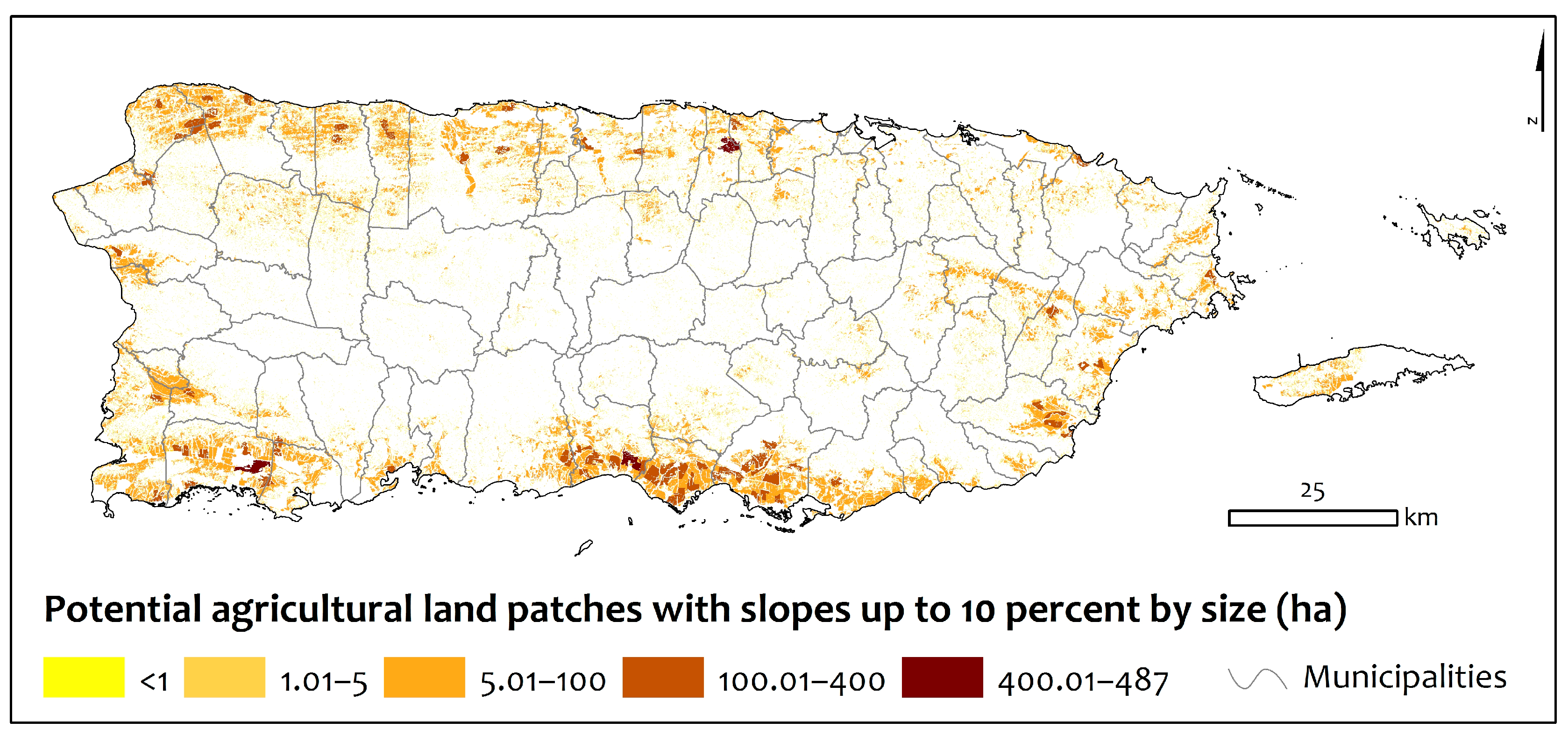
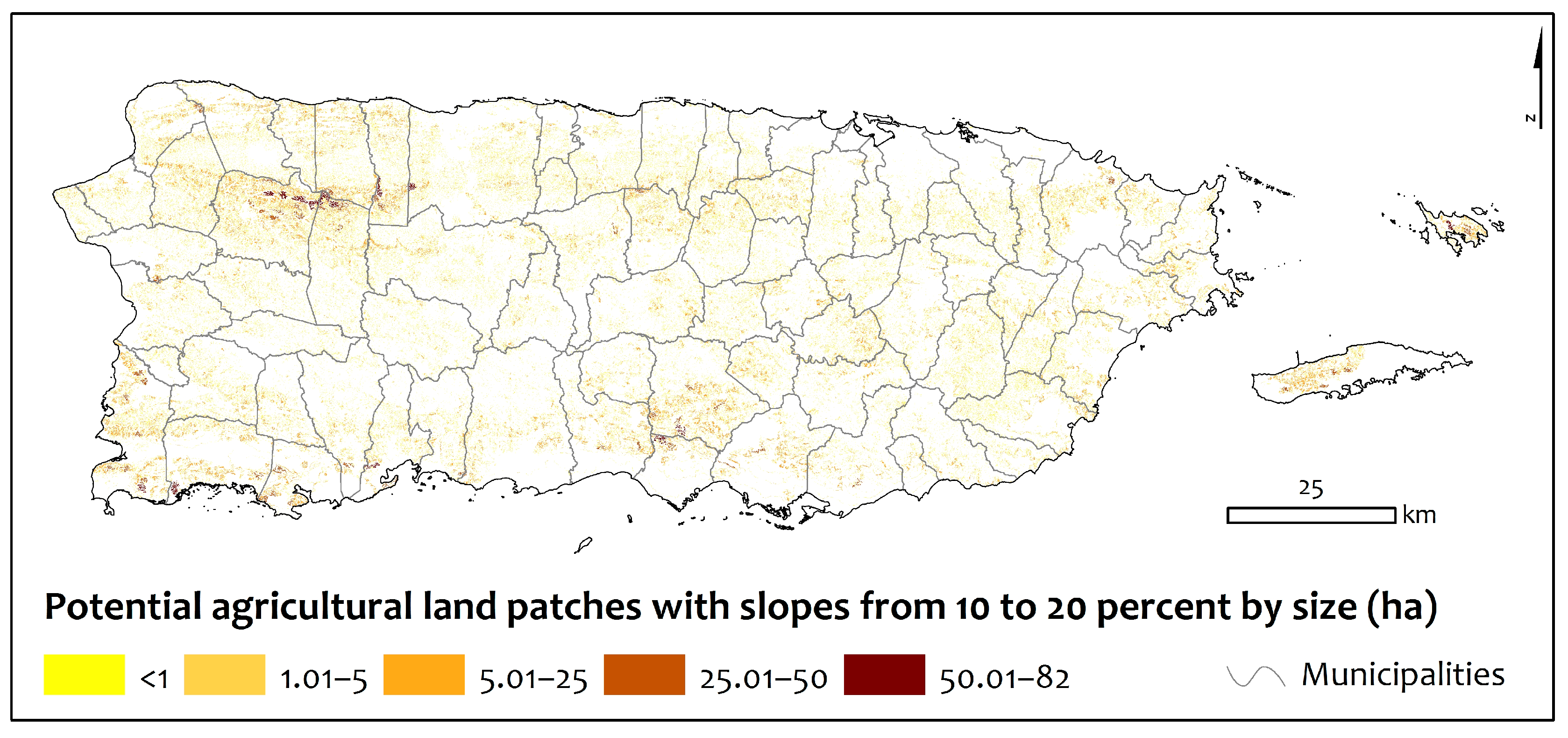
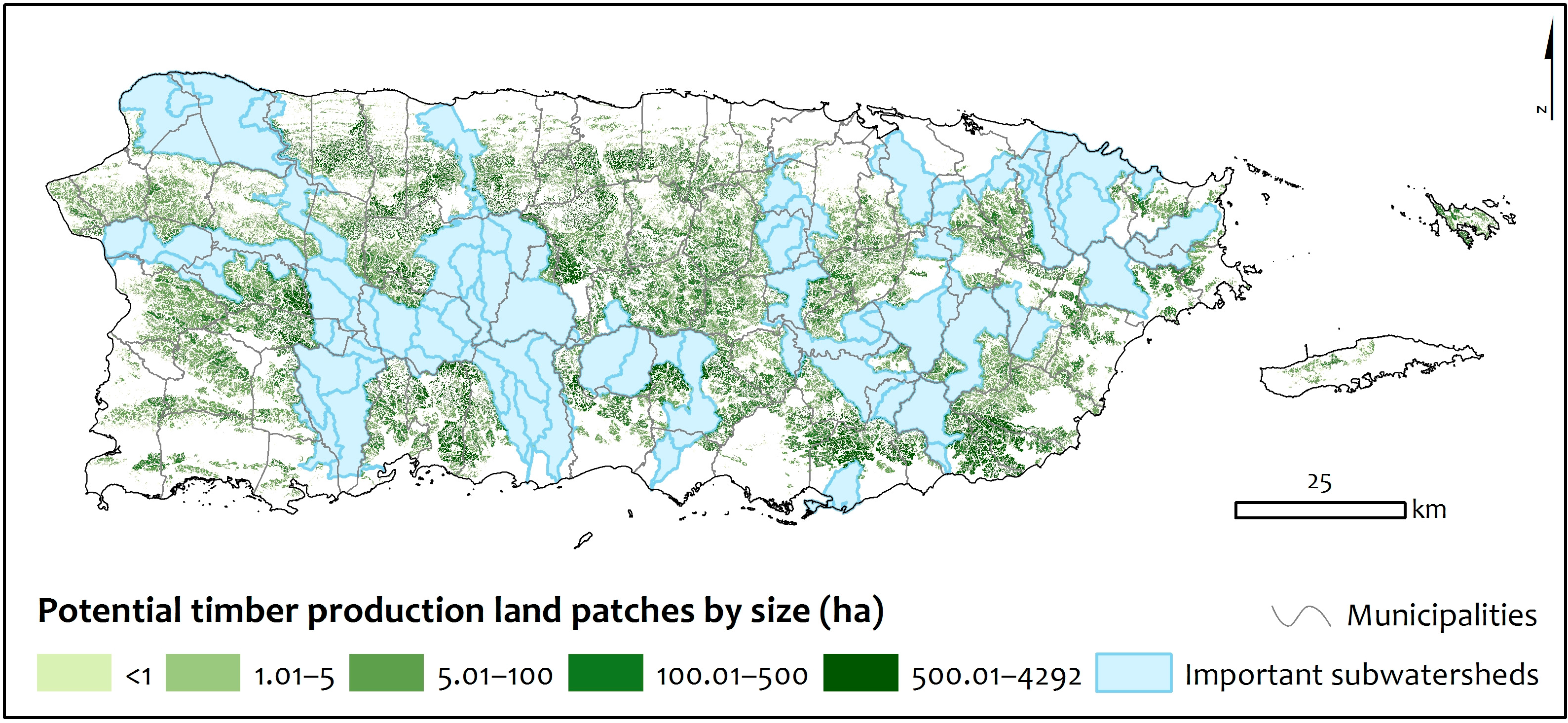
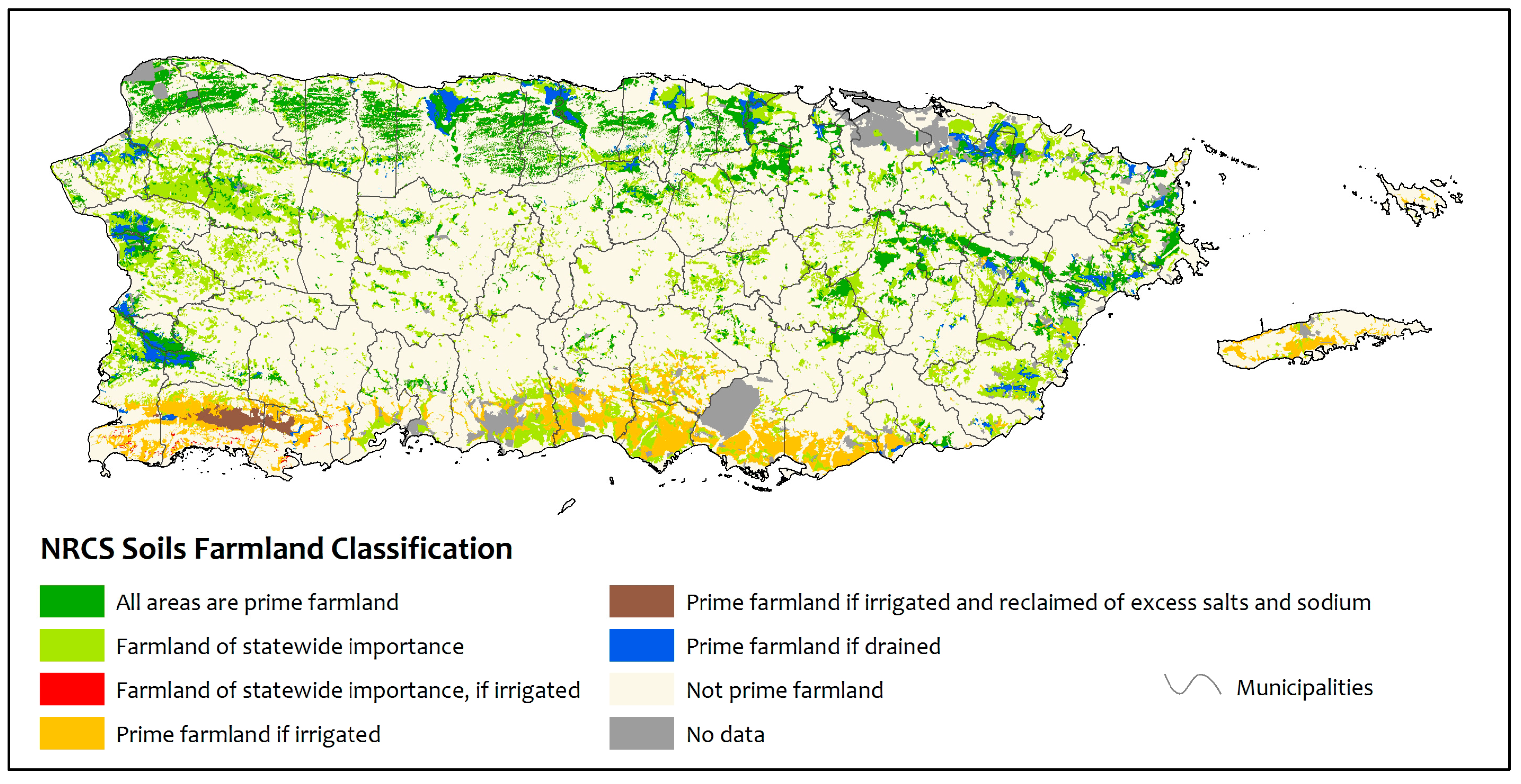
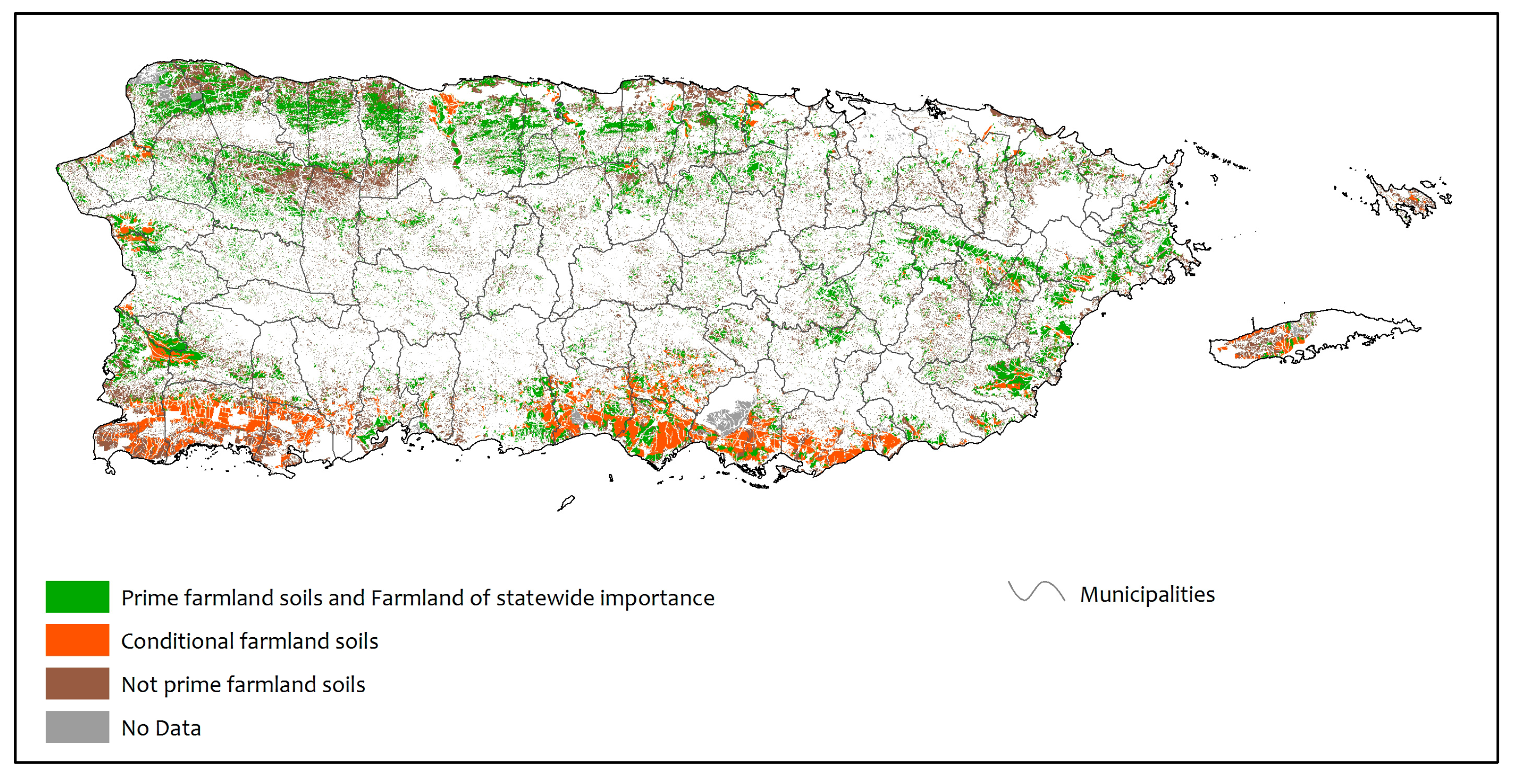
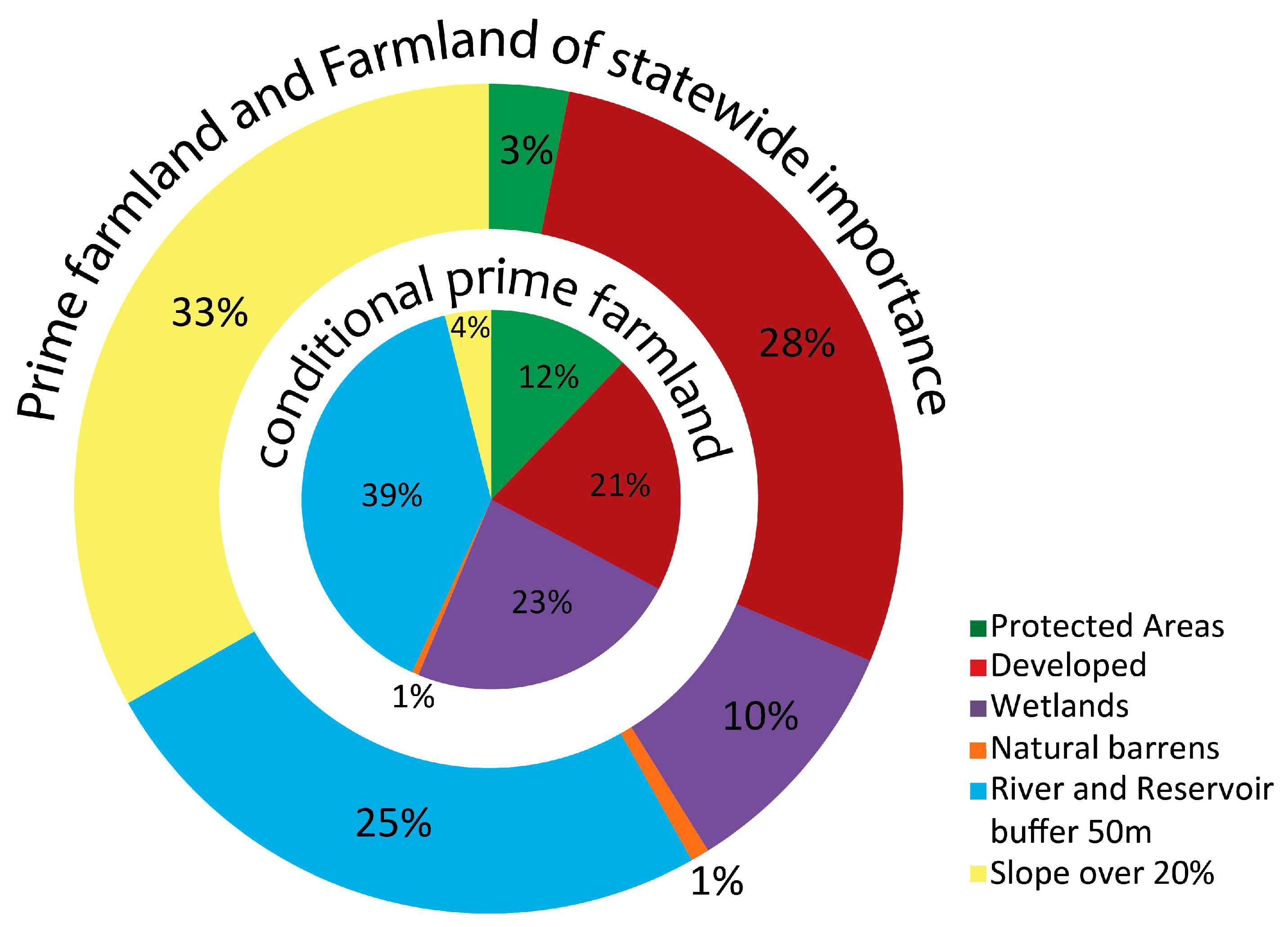

| Land Class | Hectares | Percent |
|---|---|---|
| Well-suited to mechanized agriculture (<10% slope) | 124,187 | 14 |
| Well-suited to non-mechanized agriculture (10–20% slope) | 84,574 | 9 |
| Well-suited to forestry (20–50% slope) | 169,125 | 19 |
| Developed (built-up, artificial barrens and roads) | 115,859 | 13 |
| Well-suited to conservation | 399,673 | 45 |
| TOTAL | 893,418 | 100 |
| Mechanized Agriculture | Non-Mechanized Agriculture | Agriculture | Forestry | |||||||
|---|---|---|---|---|---|---|---|---|---|---|
| Land Cover | <10% Slope | 10–20% Slope | <20% Slope | 20–50% Slope | Conservation | |||||
| Classification [20] | Hectares | % of Total | Hectares | % of Total | Hectares | % of Total | Hectares | % of Total | Hectares | % of Total |
| Forest | 17,686 | 14 | 27,598 | 33 | 45,285 | 22 | 85,918 | 51 | 210,182 | 53 |
| Natural barren | 0 | 0 | 0 | 0 | 0 | 0 | 0 | 0 | 1063 | 0 |
| Grassland and agriculture | 93,219 | 75 | 42,657 | 50 | 135,876 | 65 | 53,679 | 32 | 87,281 | 22 |
| Woodland and shrubland | 12,948 | 10 | 14,264 | 17 | 27,212 | 13 | 29,493 | 17 | 58,224 | 15 |
| Forested wetlands | 0 | 0 | 0 | 0 | 0 | 0 | 0 | 0 | 8482 | 2 |
| Non-forested wetlands | 0 | 0 | 0 | 0 | 0 | 0 | 0 | 0 | 26,586 | 7 |
| Water | 66 | 0 | 0 | 0 | 66 | 0 | 0 | 0 | 7660 | 2 |
| TOTAL | 123,919 | 100 | 84,519 | 100 | 208,438 | 100 | 169,090 | 100 | 399,478 | 100 |
| Mechanized | Non-Mechanized | Combined | ||||||||
|---|---|---|---|---|---|---|---|---|---|---|
| Agriculture | Agriculture | Agriculture | Forestry | |||||||
| <10% Slope | 10–20% Slope | <20% Slope | 20–50% Slope | Conservation | ||||||
| Land Use Plan [32] | Hectares | % of Total | Hectares | % of Total | Hectares | % of Total | Hectares | % of Total | Hectares | % of Total |
| Water | 200 | 0 | 76 | 0 | 276 | 0 | 55 | 0 | 9478 | 2 |
| Specially protected rustic lands for agriculture or in combination with agriculture | 59,091 | 48 | 26,112 | 31 | 85,203 | 41 | 47,211 | 28 | 117,564 | 29 |
| Common rustic lands | 20,812 | 17 | 24,249 | 29 | 45,061 | 22 | 51,457 | 30 | 68,960 | 17 |
| Specially protected rustic lands for conservation, not agriculture | 18,830 | 15 | 22,370 | 26 | 41,200 | 20 | 59,190 | 35 | 184,102 | 46 |
| Potential urban | 1522 | 1 | 1141 | 1 | 2662 | 1 | 1759 | 1 | 2033 | 1 |
| Urban, not necessarily built | 23,590 | 19 | 10,608 | 13 | 34,197 | 16 | 9445 | 6 | 17,533 | 4 |
| TOTAL | 124,044 | 100 | 84,556 | 100 | 208,600 | 100 | 169,116 | 100 | 399,671 | 100 |
© 2017 by the authors. Licensee MDPI, Basel, Switzerland. This article is an open access article distributed under the terms and conditions of the Creative Commons Attribution (CC BY) license (http://creativecommons.org/licenses/by/4.0/).
Share and Cite
Gould, W.A.; Wadsworth, F.H.; Quiñones, M.; Fain, S.J.; Álvarez-Berríos, N.L. Land Use, Conservation, Forestry, and Agriculture in Puerto Rico. Forests 2017, 8, 242. https://doi.org/10.3390/f8070242
Gould WA, Wadsworth FH, Quiñones M, Fain SJ, Álvarez-Berríos NL. Land Use, Conservation, Forestry, and Agriculture in Puerto Rico. Forests. 2017; 8(7):242. https://doi.org/10.3390/f8070242
Chicago/Turabian StyleGould, William A., Frank H. Wadsworth, Maya Quiñones, Stephen J. Fain, and Nora L. Álvarez-Berríos. 2017. "Land Use, Conservation, Forestry, and Agriculture in Puerto Rico" Forests 8, no. 7: 242. https://doi.org/10.3390/f8070242




